When it comes to purchasing a new guitar or upgrading your old one, what’s the first thing that you think about? Perhaps it’s the nut, the pickups, the scratch plate, or maybe simply the strings. One element of the guitar that I often think is overlooked in terms of upgrades is the fretboard – there are tons of different types of fretboard out there available for you to buy in the form of a pre-built guitar or as an upgradable piece of guitar gear.
There are so many out there, but I’ve always been particularly fond of Indian Laurel fretboards.
Never heard of them? They’re not that well-known to be fair, and I have no idea why, as they are some of the best fretboards that I have come across. Join me on this guide to the history of Indian Laurel fretboards to learn something new. I’ll be covering where they come from, why guitarists like me love to use them, what you should look out for when purchasing one, and even some product recommendations of my own. Read on to find out more!
Bottom Line Up Front: Indian Laurel fretboards have been made from the South Asian Laurel tree for decades, although they are growing in popularity now due to them spreading across the world resulting in an abundance of the plant.
If you’re an aspiring acoustic luthier, a fretboard such as that from Luthiers Mercantile International will do great, but if you just want to try the fretboard out on a new electric guitar, I’d highly recommend the Epiphone Slash Les Paul Standard in Vermillion with an Indian Laurel fretboard!
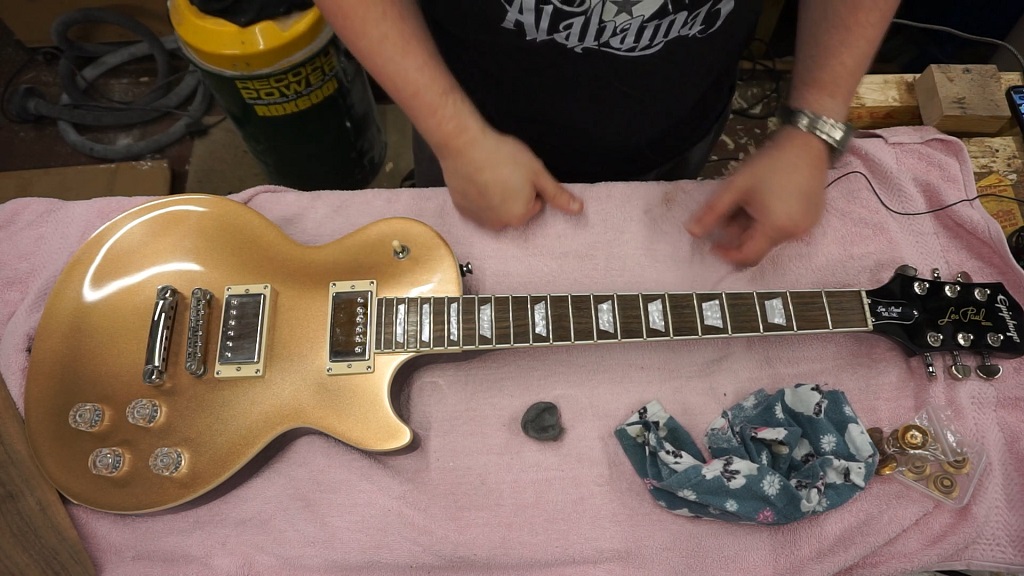
Why Choosing the Right Fretboard Is Important
Before we take a specific look at Indian Laurel fretboards, let’s quickly discuss fretboards in general. When people look at purchasing a new guitar, fretboards are not the first thing they generally think about. They’ll usually consider the top wood and body first, and that’s fair enough – most of the tone and resonance in a guitar comes from the bulk of the wood that it is made out of.
They’ll also be thinking about other core components such as the pickups, the nut, and the tonal controls. These are all important, but I wouldn’t say that they are any more important than the fretboard.
The most obvious reason that fretboards are an important thing to consider when purchasing a guitar is their ease of use – after all, your left hand (or right hand if you’re left-handed) spends the majority of the time you are playing guitar navigating it. If a fretboard isn’t comfortable or if it can’t withstand the tension of guitar strings, you’re going to have an unplayable instrument.
Therefore, it’s crazy not to think about the fretboard when looking at the components of your guitar – it’s just as important as any other core component of the instrument.
However, it’s not just about comfort and functionality – fretboards also affect the sound of your guitar. Some people claim that this is bogus, but I think they just have their ears blocked. It’s undeniable that the sonic qualities produced by fretboards are subtle, especially in comparison to the core tonewoods of the instrument, but they make a difference.
There are also additional elements such as the feel of your fingers on the fretboard, and even the appearance. After all, we all want our guitars to not only sound cool but to look cool too! Overall, there are a vast number of reasons why you should carefully choose your guitar fretboard. Now, let’s take a look at one of my favorite options in this category – the Indian Laurel fretboard.
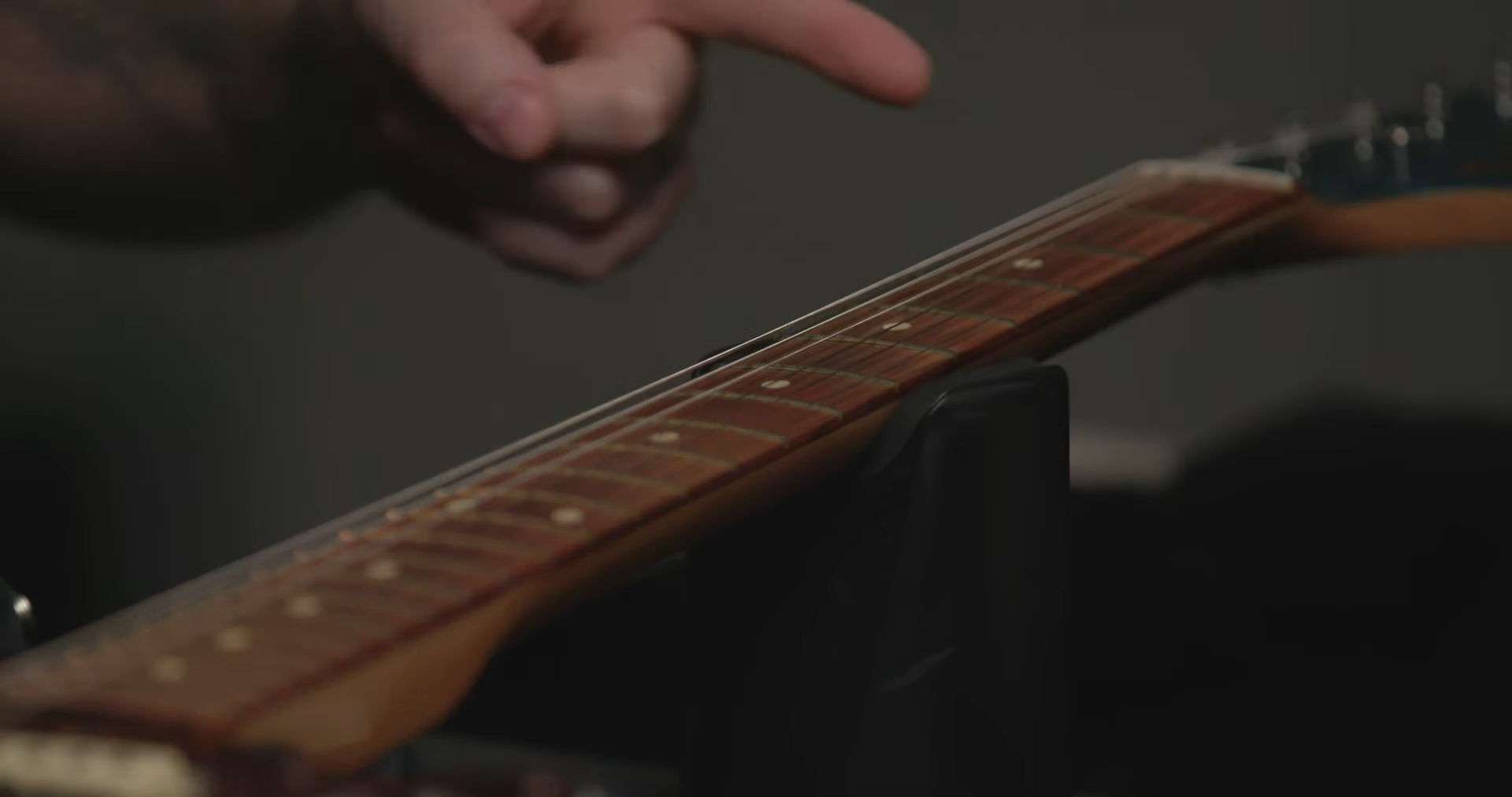
The History and Origins of Indian Laurel Fretboards
The Indian Laurel is a tree commonly found in Southeast Asia, India, and Sri Lanka, as the name would suggest. It’s existed for millennia, and it produces a fig-like fruit that is eaten by humans and animals alike. However, we’re not here to talk about the delicious fruits of the Indian Laurel, but the wood that it is composed of!
Also known as the India Walnut or India Wood, the India Laurel tree is composed of moderately hard wood, and decades ago when electric guitars were first being produced, this moderate hardness made it an excellent choice for fretboards.
It was hard enough to endure lengthy guitar performances, yet it wasn’t so hard in that it didn’t have the flexibility to handle the tension of a truss rod and guitar strings. Ultimately, this made it an excellent candidate for fretboards, and just like that production began.
However, this didn’t last too long, as many guitar producers quickly gained access to Rosewood, a type of tropical tree that grows all over the world. Despite having some pretty similar qualities in terms of tone, feel and strength, the abundance of Rosewood worldwide made it a far better option than Indian Laurel.
It was more accessible in many locations, meaning guitar producers didn’t have to spend a fortune to export it from India as they did with Indian Laurel. Just like that, Rosewood quickly took over Indian Laurel in terms of fretboard usage.
This didn’t last forever either though – in fact, the use of Rosewood is mostly banned for use by guitar manufacturers these days ever since it was discovered that many Rosewood species became endangered due to excessive use. This has led to guitar producers having to look elsewhere for their fretboard materials, and Indian Laurel shines once again.
Whilst it is natively only available in South Asia, the tree has been introduced to many other countries in recent years for decorative purposes. Birds have eaten its fig produce and spread the seeds wide through their droppings, and ultimately this has resulted in an abundance of Indian Laurel trees.
This has only meant one thing – Indian Laurel is now a widely accessible wood to guitar manufacturers and considering its similarities to Rosewood, its relative obscurity is slowly changing. Whilst I wouldn’t be surprised if you’ve never heard of it, I bet you will start seeing it all around you from now on.
Now, let’s take a closer look at why Indian Laurel fretboards are doing so well these days and why you should perhaps consider upgrading your guitar with one!
Read also: How to properly clean your Fretboards.
The Qualities of an Indian Laurel Fretboard
Whilst it’s undeniable that certain elements of a guitar are more essential in terms of stand-out features such as the body, pickups, and tonal controls, Indian Laurel fretboards still have a lot to say. From their appearance to the way they feel to play and the tones they produce, there’s a lot you still need to learn about these fine fretboards – let’s break it down.
The Feel
Towards the beginning of this article, I briefly mentioned how important it is to have a fretboard that feels good – after all, your fingers spend the entire time that you are playing the guitar navigating the fretboard via the neck.
For this reason, you need to have a fretboard that feels good under your fingers, that is comfortable to play, and that isn’t exhausting to use. Sure, you could technically use any old piece of scrap wood as a fretboard, but trust me, it’s not going to feel pretty!
Thankfully, Indian Laurel fretboards are fantastic in this department. I have always found them very soft on my fingers, unlike some of the other cheap fretboard woods I have come across. My fingers feel like they can seamlessly explore the fretboard from top to bottom, with no friction preventing me from more complex riffs and decorative techniques.
I will mention that when I first used an Indian Laurel fretboard, it did feel a bit unusual. Something about the texture of the wood felt a bit dryer than what I was used to, almost as if it needed lubrication. This almost put me off the wood to begin with, and I nearly put down my upgraded guitar and started removing the fretboard to replace it with my old rosewood fretboard.
However, it only took a few more practice sessions until I got used to the feel of Indian Laurel. After a while of playing it, Rosewood felt strange too – that’s just the way the cookie crumbles!
Indian Laurel overall feels great as a fretboard, and you won’t have any problems in terms of unlocking rapid riffs and long slides as the wood is perfectly suited for it. Just bear in mind that you may experience somewhat of a learning curve, but this is normal – you’ll get used to it soon enough.
The Tone
I would always argue that comfort and accessibility is the most essential element to look for in a good fretboard, but the tone comes second place every time. However, as I mentioned earlier, many guitarists claim that fretboards do not affect the tonal qualities of a guitar in the slightest. Just trust me on this one – they are wrong, and they either do not fully understand how to listen out for tonal intricacies, or their ears are stuffed with cotton wool!
I challenge you to find two identical guitars except one has an Indian Laurel fretboard and one has a more traditional Rosewood fretboard… I guarantee that you will be able to hear a difference. If you don’t have too keen of an ear, you could also record them separately and analyze them in visual sonification software such as Audiosculpt – you’re going to see a difference in the sonic frequencies and partials for sure!
So, what exactly does Indian Laurel sound like? Well, I have always found that Indian Laurel fretboards are some of the most well-rounded and balanced fretboards out there. Compare the tone to a typical Rosewood fretboard, and I think you will find that Rosewood holds much more dominance in the low-frequency range.
This is great if you like to focus more on open chords and low-fret power chords, but if you like to explore the full range of your fretboard and even throw in a cheeky solo or two, you will notice a slight lack in high and mid frequencies. Indian Laurel is simply more balanced, and when it comes to perfecting your guitar tone, balance is essential to form your tonal backbone.
I’m not trying to say that it’s worth spending a ton of extra money on an Indian Laurel fretboard just for that additional tonal balance. However, I think it’s worth considering that it does make a difference, and it’s certainly not worth shying away from it just because Rosewood is a more common household name. Indian Laurel is a perfectly good fretboard material tonally and can easily out-perform more popular woods, despite being a cheaper option.
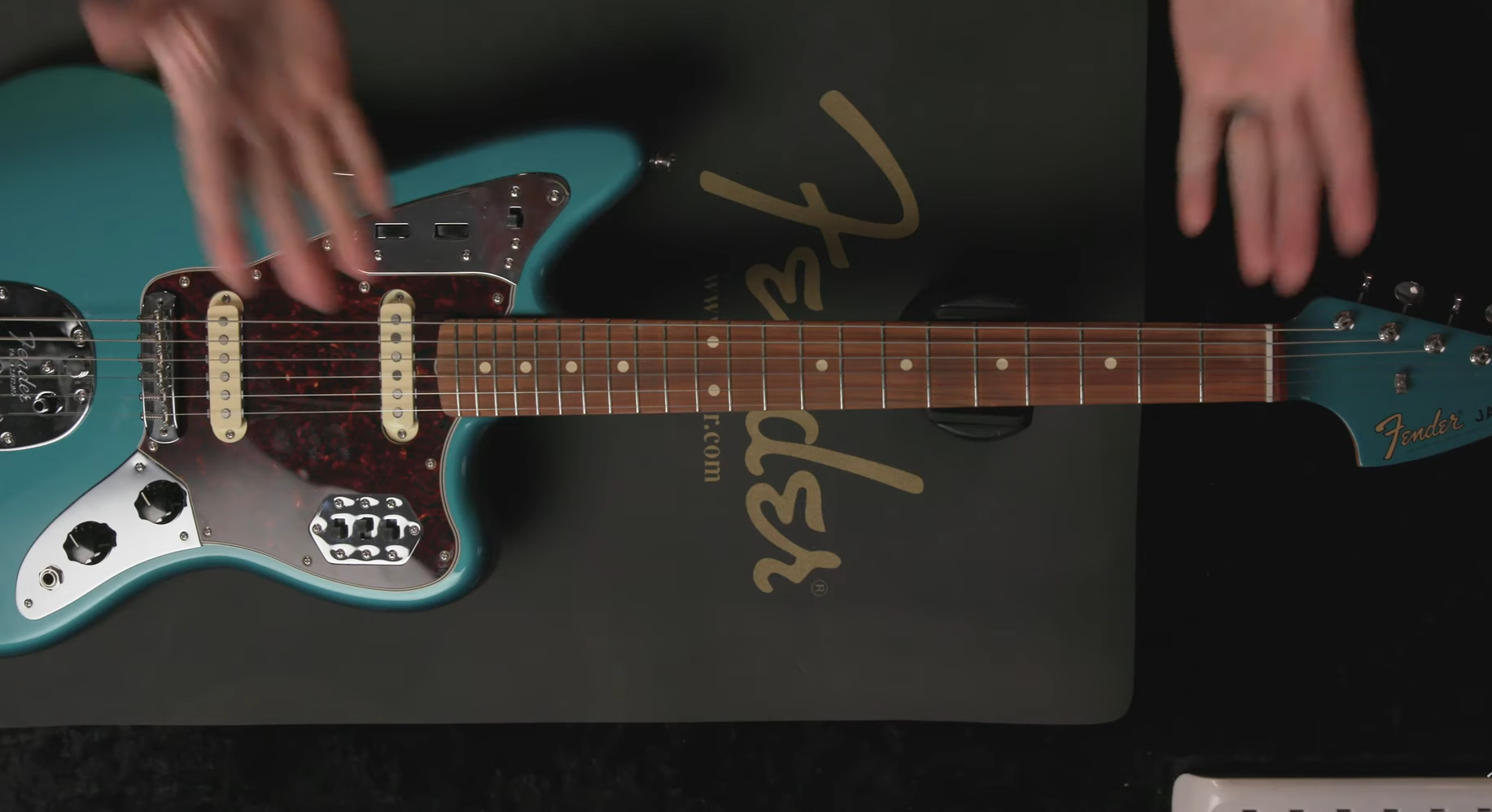
The Look
The final thing that you should always consider when looking to upgrade your guitar with an Indian Laurel fretboard is the look of it. Now, you might be thinking that this is unnecessary – surely the tonal qualities and the comfort are practical reasons that truly matter, whereas the look is simply superficial. Well, whilst that may well be true, there’s nothing wrong with a bit of superficial aesthetic appreciation now and then.
In the case of most guitars, fretboards form the largest part of a guitar in terms of length. People rarely condone choosing a beautiful finish for a new guitar, so why would you feel like that regarding a guitar part that is far larger and way more visible!? You certainly shouldn’t be choosing a fretboard only because it looks cool, but if looking cool is a natural byproduct then why not appreciate it!?
Thankfully, the appearance of Indian Laurel is awesome. When applied to fretboards, it appears medium brown, with occasional streaks of darker brown. The grain is nice and straight, and this provides the wood a highly glossy finish, I love it. When compared to Rosewood, I’d forgive you if you claimed that they look the same. Much like comparing the tonal profiles, the visual differences are very subtle and you need to look closely to notice them.
I would personally describe Indian Laurel as being slightly darker overall than Rosewood. The colors are also a lot more consistent and balanced throughout, as opposed to Rosewood which can often feel like it is creating a visual gradient. This comes down to personal preferences, with some people preferring the sloped colors of Rosewood. However, I’ve always preferred the consistency of Indian Laurel – that’s just my opinion!
My Top 3 Indian Laurel Fretboard Recommendations
Whether you’d never heard of it or you were seeking out a deeper insight, you should now have a better understanding of what Indian Laurel fretboards are and where they came from. You might be eager to rush online and grab yourself that guitar you’ve had your eyes on that includes an Indian Laurel fretboard.
Not so fast – I’ve got some recommendations that could be of interest to you! From fully completed guitars to independent Indian Laurel fretboards for you to upgrade your guitar with, I’ve made sure to cover all the bases. I hope they serve you some inspiration!
Squier Bullet Stratocaster HT with Indian Laurel Fretboard
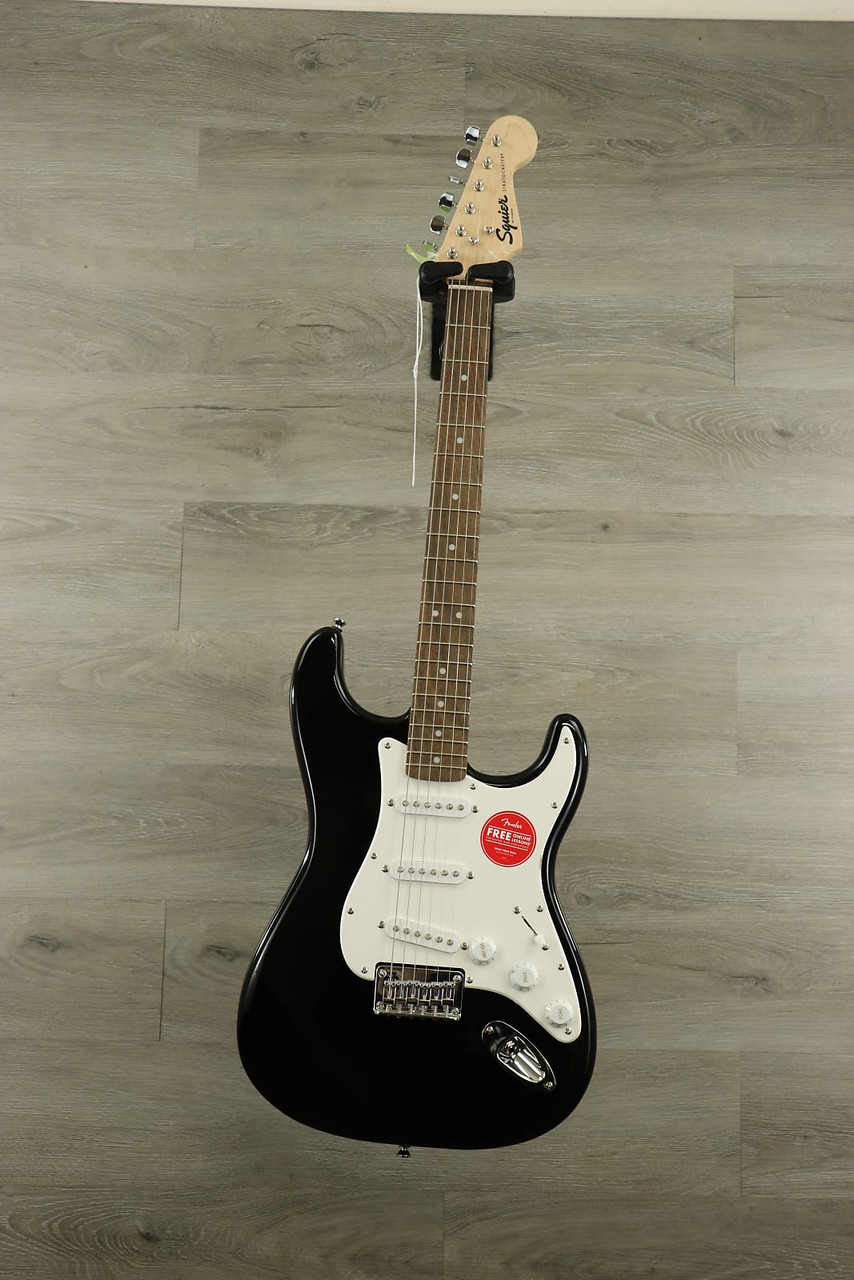
To kick things off, let’s start simple with a completed guitar by none other than Squier – the Squier Bullet Stratocaster HT with Indian Laurel Fretboard. This guitar is an absolute throwback for me – my first guitar was a Squier, and whilst they may not be the most glamorous guitars, they are fantastic for beginners and intermediate players. They have thin and lightweight bodies, accessible C-shaped neck profiles, and a hardtail bridge for fantastic tuning stability, and they look great too.
I’m not going to pretend that this guitar is a work of art – it’s a cheap model and Squier is well known for being great as beginner guitars. However, I think that it is a fantastic example of how Indian Laurel fretboards can shine under any condition, from the cheapest beginner guitars to more expensive professional models. If you don’t have the cash to splash, I’d highly recommend this Indian Laurel guitar!
Pros
- Made by Squier, a company well known for producing decent beginner guitars
- You can’t beat the price, it’s so cheap!
- C-shape neck profile for increased fretboard accessibility
- Thin and lightweight body
- Hardtail bridge for excellent tuning stability
Cons
- It’s a squire, so don’t expect exceptional quality
- The appearance is fairly basic and a bit bland
Luthiers Mercantile International’s Indian Laurel Blank Fretboard for Classical and Steel String Guitars
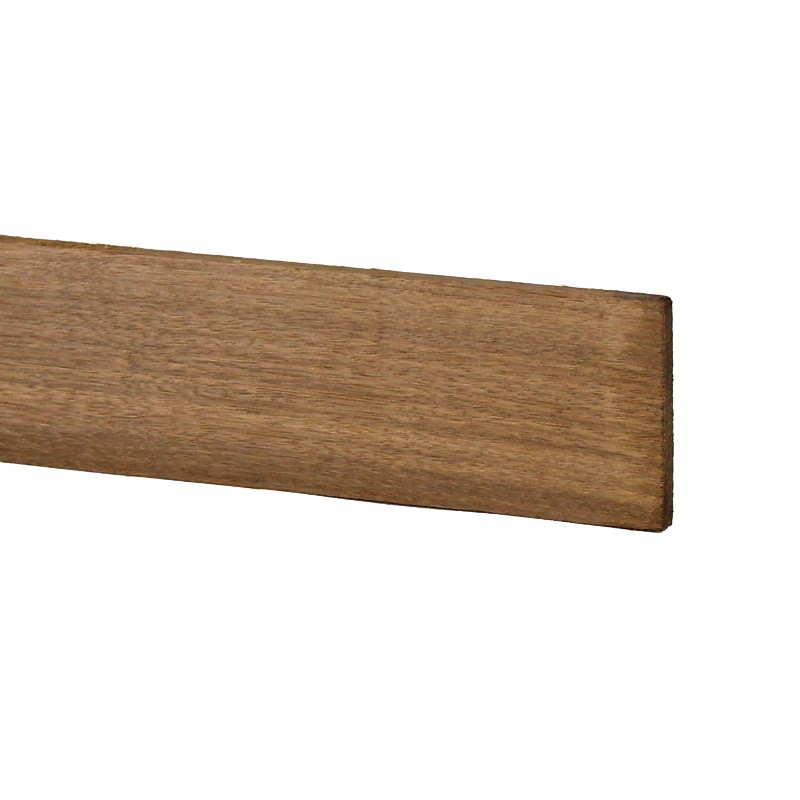
Next up is something a little different, a standalone Indian Laurel fretboard from the fantastic guys over at Luthiers Mercantile International. I have relied on this company several times to provide me with different parts for DIY guitar projects, most recently being this exact product. It’s going to be a bit useless if you’re looking for a ready-to-play guitar, but if you like a challenge, why not consider purchasing this and building your own? It’s just over ten bucks, so it’s a steal.
This fretboard has a thickness of 5/16″, made from 2nd grade Indian Laurel specifically for classical and steel string guitar. If that’s the kind of project you’re looking to work on then look no further – it’s a very attractive wood with an even brown color augmented by a subtle dark cross-grain figure.
It glues and machines perfectly, so it’s excellent for any building project. The only downside is that this fretboard is only suitable for acoustic classical and steel string guitar builds, not electric guitars, so bear that in mind.
Pros
- Luthiers Mercantile International is a well-known brand for DIY guitar projects
- Ideal for DIY acoustic classical and steel-stringed build projects
- Unbelievably cheap
- An even brown color complemented by subtly dark cross-grain textures
Cons
- A bit useless if you want to purchase a pre-built guitar
- Not suitable for electric guitar build projects
Epiphone Slash Les Paul Standard In Vermillion Burst
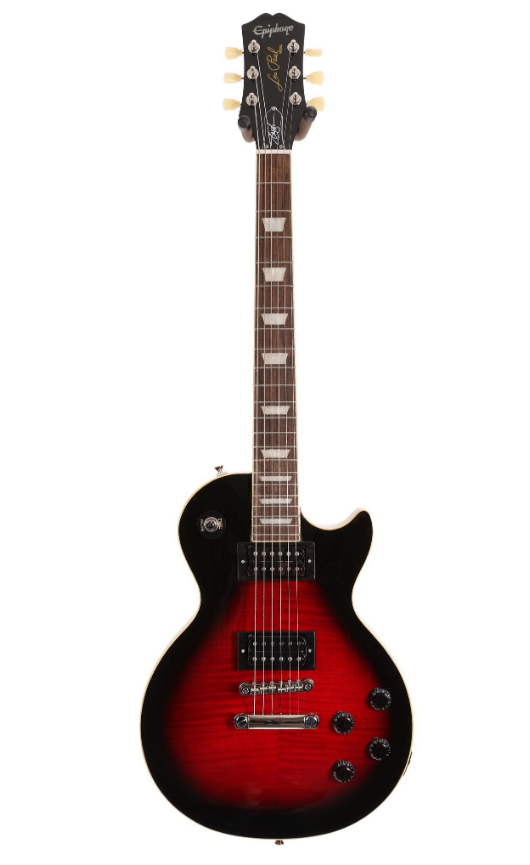
The final product recommendation on my list is none other than the Epiphone Slash Les Paul Standard in Vermillion Burst. I flipping love this guitar – I’ve always been in love with Les Pauls, particularly when Slash performs with them, but I’ve never been able to justify paying for an expensive yet luxurious Gibson Les Paul. However, thanks to Epiphone, my dreams have been made possible, and this one even includes an Indian Laurel fretboard!
Along with a mahogany body and neck, an Epiphone LockTone Tune-O-Matic bridge, and a Stop Bar tailpiece, this guitar features some classic personal touches from Slash himself including a C-shape neck profile, custom Epiphone ProBucker pickups, and even an illustration of Slash’s signature on the back! If the sexy Indian Laurel fretboard and other touches weren’t enough, this guitar even comes with a hardshell case for free! What more could you want?
Pros
- Epiphone Les Pauls allows you to enjoy the beauty of an Indian Laurel Les Paul, without the price of a Gibson
- Beautiful Vermillion Burst finish
- Epiphone LockTone Tune-O-Matic bridge
- Epiphone ProBucker pickups
- Features a print of Slash’s signature!
Cons
- Expensive, especially if you’re only looking for an Indian Laurel fretboard
- If you’re not a fan of Slash, you might find it strange to have his signature on your guitar
FAQs
Well, that just about brings us to the end of this guide to the history of Indian Laurel fretboards! I hope that I was able to teach you a lot and that you appreciated my product recommendations. To finish things up, let’s quickly go over the answers to some of the most frequently asked questions regarding Indian Laurel fretboards – I hope that they can help you out!
Question: What Is an Indian Laurel Fretboard?
Answer: An Indian Laurel fretboard is a guitar fretboard made from the wood of Laurel trees found in South Asia, known for its sturdy nature and balanced tonal profile.
Question: Are Indian Laurel Fretboards for Acoustic or Electric Guitars?
Answer: Both! Indian Laurel fretboards make fantastic alternatives to traditional rosewood fretboards for both electric and acoustic guitars.
Question: Why are Indian Laurel Fretboards So Cheap?
Answer: The cheapness of Indian Laurel fretboards has nothing to do with their quality – it’s due to the plant spreading across many tropical climates, resulting in an abundance of the tree in comparison to rosewood.
Final Thoughts
Well, that’s just about everything I have to teach you regarding Indian Laurel fretboards! They are wonderful bits of kit made from a highly unique tree, and with many types of rosewood being banned, I think it’s likely that you will start to see more of it in the future.
Whether you go for a standalone fretboard such as that from the Luthiers Mercantile International’s stock or a pre-built guitar such as the Epiphone Slash Les Paul, I’m sure you’ll be pleased with the tone of the fretboard.
Personally, I’d choose the Les Paul though because c’mon, they’re wicked guitars! I wish you all the best on your journey, and don’t forget to research every company and luthier you purchase from to ensure they’re the real deal! Thanks for reading.
- Where to Sell Guitars Online - August 23, 2023
- How to Find The Most Versatile Electric Guitars - August 22, 2023
- Best Squier Jazz Basses Guide - August 22, 2023

